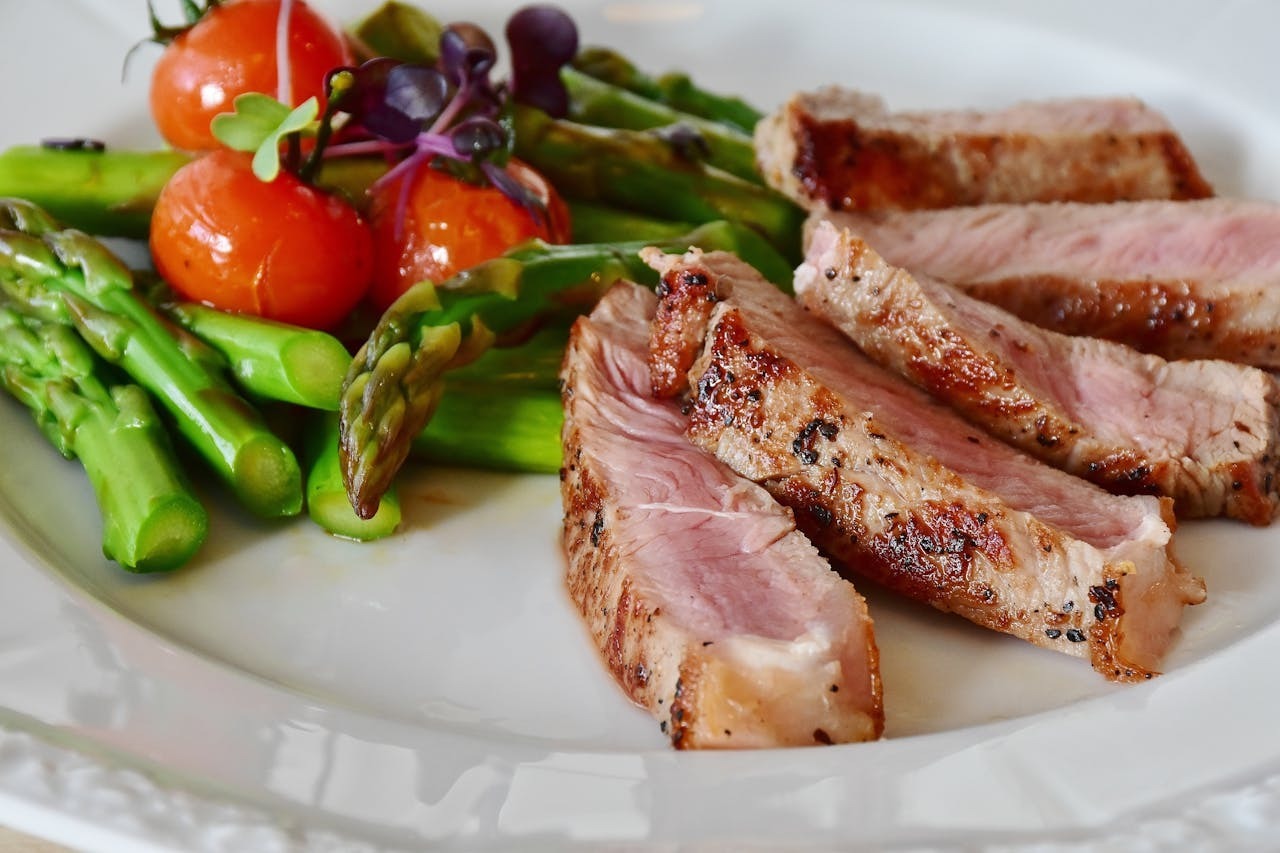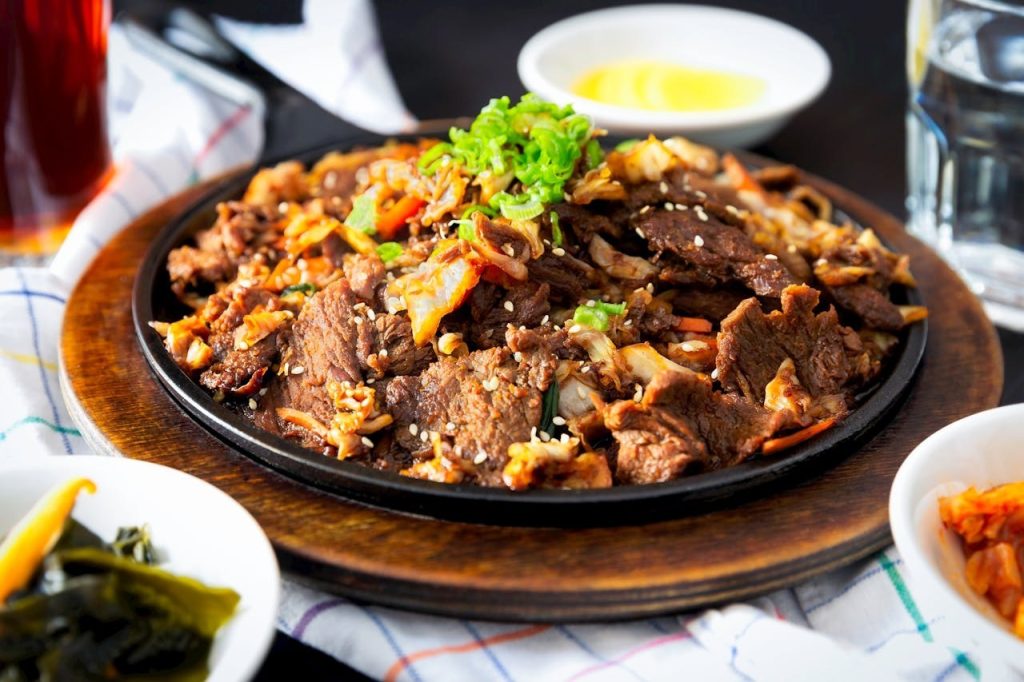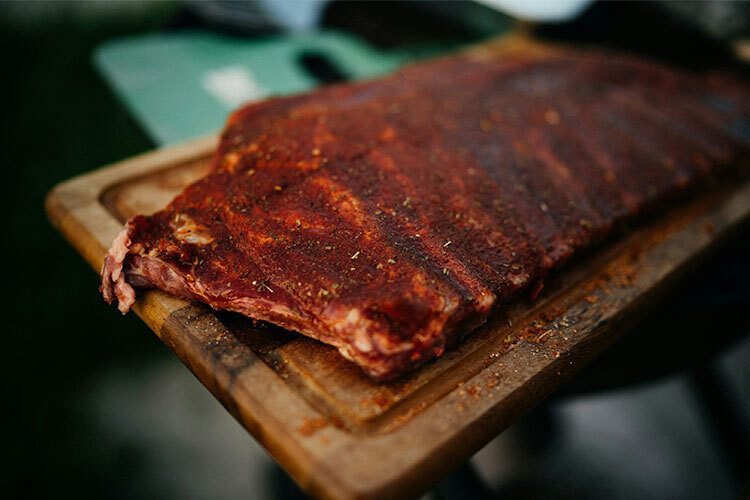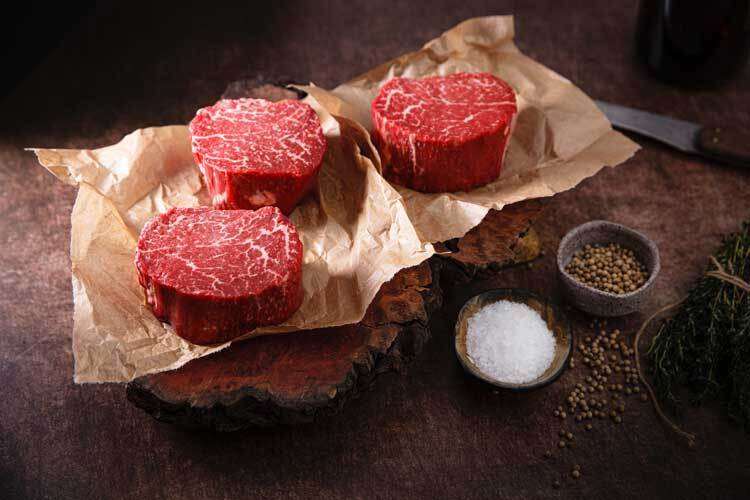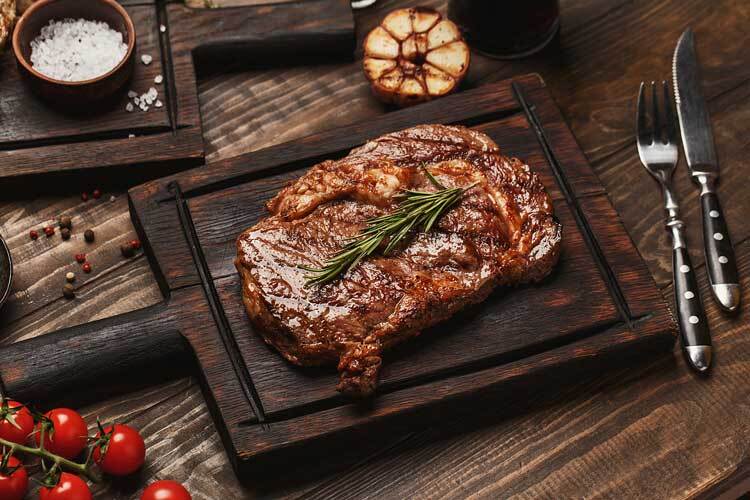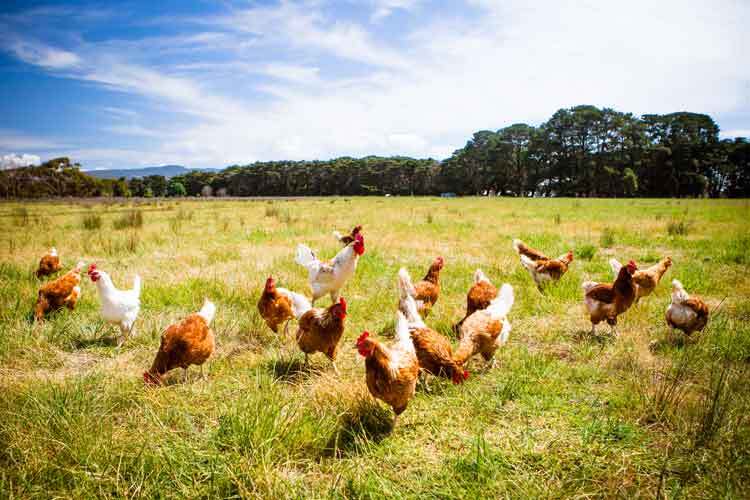Pairing beef with the right wine or beer can transform an ordinary meal into an extraordinary dining experience. While Ontario is renowned for its tender and flavourful beef, determining which wine or beer best complements different cuts requires some knowledge. This guide provides a primer on pairing the most popular Ontario beef cuts with wines that enhance their flavours.
We’ll explore everything from lighter Pinot Noirs to full-bodied Cabernet Sauvignons and the array of crisp to malty beers that effortlessly match prime rib, striploin, tenderloin and other distinctive cuts. Properly pairing beef and wine accentuates the intricate flavours in both, creating a sensational symbiotic relationship.
Beyond the taste, wine and beer can also aid digestion and round out the meal aesthetically. Our guide focuses on classic pairings that have stood the test of time. We’ll provide an overview of the flavour profiles in various beef cuts and how to seamlessly match them with wines and beers that make them shine. Whether you’re planning a romantic dinner or hosting a celebratory barbecue, use this as your handbook to take your beef to the next level.
Popular Cuts of Ontario Beef
Ontario is renowned for its high-quality beef. When pairing beef with wine or beer, consider the cut, as this impacts the flavour intensity and fattiness.
Striploin
Striploin is a lean, tender cut from the short loin. It has a delicate beefy flavour that pairs well with medium-bodied red wines that won’t overpower the subtleties of the striploin. Due to its versatile flavour, striploin can also pair nicely with a variety of beers.
Ribeye
Ribeye comes from the rib section and is marbled with fat, which keeps it juicy while lending rich flavour. The generous marbling means ribeye can stand up to full-bodied wines with oak notes. Malty brown ales also complement the hearty ribeye beautifully.
Sirloin
Sirloin is a lean, moderately tender cut from the hip/rear end. It has a robust flavour that pairs well with medium to full-bodied wines with spicy or earthy flavours. Nut brown ales and porters also make great partners for sirloin.
Ground Beef
Ground beef is often made from trimmings of various cuts. For richly flavoured dishes like burgers or meatballs, pair with medium to full-bodied wines with oak and dark fruit. Crisp pale ales and lagers cut through the richness beautifully.
Light Red Wines
Pinot Noir, Gamay, and Cabernet Franc tend to have light bodies and lower tannins compared to bigger reds like Cabernet Sauvignon or Malbec. They feature fruity flavours like raspberry, strawberry, cherry, and plum that pair nicely with the umami richness of beef.
Pinot Noir offers fresh acidity and light red fruit notes that cut through fattier cuts like ribeye or tenderloin beautifully. The peppery spice of Pinot Noir also complements charred and grilled flavours. For grass-fed Ontario beef, local Pinot Noirs from Prince Edward County or Niagara are excellent options.
For a bit more boldness, Gamay is a go-to pairing for many beef dishes. Originating from Beaujolais in France, Ontario Gamay often expresses tart cranberry and cherry notes along with savoury herbaceousness. The bright acidity of Gamay balances rich meat exceptionally well. Try it with grilled strip loin or flank steak.
Cabernet Franc is right at home with Ontario beef, as it thrives in cooler climates here. Enticing red and black fruit with accents of green bell pepper and tobacco make it a versatile match for anything from burgers to braised short ribs. The moderate tannins won’t overpower beef flavours either. Cabernet Franc offers an easy-drinking complement.
Medium-Bodied Red Wines
When it comes to pairing Ontario beef with wine, medium-bodied reds are a versatile match that work well with a variety of cuts and preparations. Some excellent options to consider are Merlot, Zinfandel, and Syrah.
**Merlot** is a popular choice that often features plum, blackberry, and herb notes. It tends to be smooth and supple on the palate. Merlot pairs nicely with tender cuts like filet mignon or striploin, as well as anything prepared with a red wine reduction sauce. The soft tannins and fruit flavours complement the savouriness of beef.
For something a bit bolder, look for a **Zinfandel**. These wines showcase jammy berry flavours along with black pepper and spice. They have enough body and structure to match ribeye, brisket, or pot roasts. The smoky notes in Zinfandel complement charred beef flavours beautifully.
**Syrah** is another excellent option. Northern Rhone styles offer blueberry, cracked pepper, and smoked meat qualities that pair wonderfully with grilled flank steak, short ribs, or tri-tip roast. The savoury, almost bacon-like notes in Syrah interplay deliciously with beef’s umami character.
When pairing beef with medium-bodied reds, look for wines with a balance of fruit and savoury flavours. The moderate tannins won’t overpower the meat but will provide enough structure to complement the meat’s texture. With a wide range of styles readily available from Ontario wineries, you’re sure to find the perfect wine match.
Full-Bodied Red Wines
Full-bodied red wines like Cabernet Sauvignon, Malbec, and Petite Sirah have intense flavours and bold tannins that can stand up to the richest beef dishes. Their ripe fruit flavours and oak aging give them the complexity to complement beef’s savoury umami flavour.
Cabernet Sauvignon is one of the most popular full-bodied reds. It often features notes of black currant, cedar, tobacco and dark chocolate. Cabernet’s firm tannins make it an excellent partner for well-marbled prime rib or ribeye steak. The sweetness of the beef’s fat balances the wine’s tannic grip. Grilled beef tenderloin is also delicious with Cabernet Sauvignon.
Argentinian Malbec offers jammy dark fruit flavours like plum, blackberry and blueberry, along with hints of thyme and black pepper. Its silky texture pairs beautifully with tender beef cuts like filet mignon or sirloin steak. Malbec’s fruity character contrasts nicely with beef’s minerality. Skirt or flank steak marinated then grilled or broiled make great matches for Malbec.
Petite Sirah is inky dark in colour with bold black fruit, smoke and pepper on the palate. It has gripping tannins that allow it to complement intensely flavoured beef like brisket or short ribs braised until fall-apart tender. Its dense fruit and oak notes balance the rich unctuousness of braised beef. Petite Sirah also pairs wonderfully with smoked brisket or tri-tip hot off the barbecue.
Rosé
Rosé wine offers light, fruity flavours that pair well with leaner cuts of beef. The bright acidity of rosé cuts through the richness of beef, while complementing grilled flavours.
Flavour Profile
Rosés are known for their dry, crisp, and light body. They exhibit notes of citrus, strawberry, peach, and melon. The acidity ranges from medium to high. Avoid sweeter rosés when pairing with beef
Best Beef Pairings
- Filet mignon – The lean cut won’t overpower the delicate rosé.
- Beef tenderloin – Accents the refined flavours.
- Hanger steak – Contrasts with the gamier notes.
- Beef carpaccio – Highlights the fresh flavours.
Look for dry rosés from regions like Provence, Spain, or South America. The citrusy whites and fruit-forward reds will work well with sear-finished steaks. Avoid oaky rosés that may clash with beef’s richness.
Light & Crisp Beers
Ontario’s craft breweries offer many excellent lighter, crisper beer styles that pair deliciously with beef. The key is matching the intensity of the beer’s flavour profile with the richness of the cut of beef.
Lagers and Pilsners
Lagers and pilsners like Creemore Springs Premium Lager, Amsterdam Natural Blonde, and Great Lakes Canuck Pale Lager offer light, clean flavours and moderate carbonation that won’t overpower beef. Their crisp, subtle maltiness pairs well with tender cuts like filet mignon or striploin. The carbonation helps cut through the richness of the beef.
Pale Ales
Ontario pale ales from breweries like Muskoka, Beau’s, and Nickel Brook range from lightly hopped to more boldly bitter. Their medium body and hoppy flavours complement umami-rich cuts like flank steak or hanger steak. The hops help balance the deep, meaty flavours. Go for an American pale ale with skirt steak fajitas or grass-fed burgers.
Wheat Beers
Craft wheat beers like Wellington County Dark Wheat and Amsterdam Wheels Up are excellent matches for barbecue beef ribs or brisket. The soft malt character, light citrus notes, and low bitterness let the sweet, smoky beef flavour shine. Hefeweizens pair nicely with braised pot roasts. The clove-like flavours complement the slow cooked meat.
Dark & Malty Beers
Dark and malty beers like stouts, porters, and brown ales make excellent pairings for rich, flavourful cuts of beef. The roasted malt flavours complement the umami savouriness of beef, while the higher alcohol content of these beers helps cut through the fattiness.
Stouts offer coffee and chocolate notes that pair nicely with ribeye, short ribs, or brisket. The slight smoky quality brings added depth when matched with grilled or smoked beef. Try pairing an Oatmeal Stout with a tender pot roast braised in stout beer.
H4 Porters have a bittersweet chocolate flavour that enhances cuts like sirloin, tri-tip, or flank steak. The mild sweetness balances the minerality of beef. Pair a Robust Porter with a juicy burger or meatloaf for a delightful blend of maltiness and beefiness.
H4 Brown Ales feature caramel, toffee, and nutty flavours that complement umami-rich cuts like chuck roast, oxtail, and beef cheeks. The malty sweetness offsets gamier meats nicely. Match an American Brown Ale with shredded beef tacos or barbacoa for a winning combo.
The roasted malt backbone of stouts, porters, and brown ales stands up well to the hearty flavour of beef. These beers add sweetness, roastiness, and smokiness that complements various cuts. Their intensity matches the rich savouriness of beef for satisfying pairings.
Pairing Sides & Sauces
Sides and sauces are an integral part of any beef meal. Choosing wines and beers that complement the flavours in these dishes is key to creating a cohesive and delicious beef pairing.
Mashed Potatoes
Mashed potatoes are a classic beef side. Their creamy, starchy texture calls for wines with a round mouthfeel. Light oak-aged Chardonnays have enough body to stand up to the potatoes’ richness. Lighter Pinot Gris or dry Rieslings also make nice matches. For beer, choose malty amber lagers or ales with low bitterness. The subtle sweetness plays off the potatoes nicely.
Grilled Vegetables
Grilled veggies like zucchini, peppers, and eggplant add great flavour contrast to beef. Their charred smokiness pairs well with medium-bodied red wines like Pinot Noir or Grenache. Fruity Belgian-style ales also complement the vegetables’ sweetness. Avoid big, oaky wines that will overpower the more delicate veggies.
Horseradish Cream
Horseradish’s sharp pungency needs a wine that can handle some spice. Go for more aromatic white wines like Sauvignon Blanc or Albariño. The fruitiness balances out the heat. Hoppy pale ales or wheat beers also stand up well to horseradish’s bold kick. Avoid delicate wines that will get drowned out.
Red Wine Reduction
Naturally, a rich red wine reduction pairs perfectly with the red wine it was made from. Match the weight and flavour intensity of the reduction to a similar wine. Light, berry-driven reductions go nicely with Pinot Noir or Gamay. Full-bodied, oak-kissed reductions need a bold Cabernet Sauvignon or Malbec. Porters and stouts complement reductions’ richness.
Blue Cheese Butter
The tangy saltiness of blue cheese butter requires wines with some sweetness. Off-dry Riesling is a classic pairing, as are fruity Pinot Gris or Gewürztraminer. The butter’s creaminess also matches well with smooth Belgian ales. Avoid dry wines and assertive beers that accentuate blue cheese’s sharpness.
In conclusion, pairing hearty Ontario beef with wines and beers can seem daunting, but this guide has aimed to make the process more approachable. The key factors are picking wines and beers that can stand up to the richness of the beef, while also complementing its flavour.
With lighter cuts like filet mignon, pinot noir, cabernet franc, Beaujolais, and pale ales are safe choices. As the meat gets fattier and richer, look to bolder reds like cabernet sauvignon, syrah, and zinfandel. Porters and stouts also pair nicely. Don’t shy away from trying different sides and sauces too. A classic bearnaise or red wine reduction sauce can really bring the flavours together.
The final tip is to have fun experimenting with different combinations and see what you enjoy most. Part of the joy is in the discovery. Just remember to pick wines and beers with enough body and flavour to hold up against the hearty Ontario beef. Your taste buds will thank you. Now it’s time to start cooking and uncorking some bottles to find your perfect pairings.


